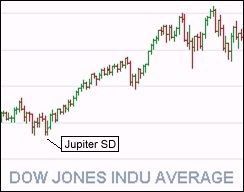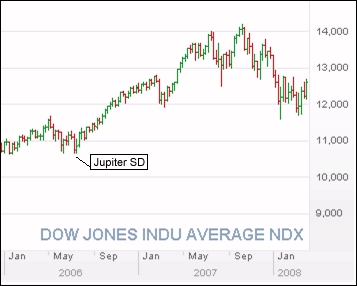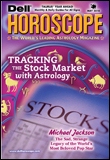
advertisements
Tracking the Stock Market
with Astrology
by Michael O'Reilly
What astrological factors influence market trends? Here's Part Three, an excerpt from the full length article featured in the cover story of Dell Horoscope magazine's May 2010 issue...

NeptuneCafe presents

Tracking Market Trends Using the U.S. Horoscope
Perhaps it's only a coincidence that the Democratic Party was founded on May 13, 1792 – only four days before the NYSE. For those who know astrology, there's no such thing as a coincidence, as these events arise out of common celestial conditions. The horoscope that reveals what the Democratic Party and the NYSE have in common is the Scorpio Rising U.S. chart. (For more info, see Democrats).
In 1792, Pluto (the ruler of the Scorpio Rising horoscope) was transiting through the fourth house of foundations and new beginnings. That year, Pluto hovered over the U.S. Moon at 25º Aquarius, which gave impetus for the creation of enduring institutions that served the American people. In addition to the NYSE and the Democratic Party, that year also saw the cornerstone for the White House laid in Washington D.C., the founding of the U.S. Post Office, and the establishment of the U.S. Mint.
The U.S. Chart and the V-Shaped Recovery
Using the words associated with the planets, signs and houses, one can build a narrative around the March 6, 2009 market bottom. First and most important is Pluto in Capricorn, which many astrologers have associated with the empowerment of government and national institutions. Since most astrologers have a strong liberal, anti-authoritarian streak running through their psyches, the empowerment of government was not seen as a good thing. To the contrary, specters of Big Brother, socialism, and other oppressive forms of government readily came to the tongue. The one big fear I hear most recently is about how the world's elite are creating a World Government under the guise of fighting global warming.
The first time Pluto opposed the U.S. Venus was on February 28, 2009, only five trading days before the Dow hit bottom at 6469. On February 24, 2009 President Obama gave a nationally televised speech to a joint session of Congress. He spoke frankly about the shaky economy and promised that "we will rebuild, we will recover, and the United States of America will emerge stronger than ever." He proposed many cost-cutting measures, and other ways of mending the faltering economy – all of which

The NYSE was founded at a time when most of the planets were forming exact links to the U.S. horoscope. These connections reflect common degree areas that become important when tracking the business cycle and stock market trends. The most direct links are also the most important in both charts. The NYSE Sun at 27º Taurus is precisely trine the U.S. Pluto (orb 0º16'), and thus provides the financial or material (Taurus) medium for American wealth and power (Pluto in Capricorn). These two planets, along with the NYSE Mercury (in Taurus) and Mars (Virgo), and the U.S. Neptune (Virgo), create a protective, self-sustaining Earth Grand Trine, so that the NYSE becomes an endless money-making machine.
The NYSE's other ruling planet is Uranus, and it's location at 15º Leo happens to be conjunct the U.S. Midheaven (orb 1º). Leo's natural inclination toward speculative ventures reaches its pinnacle in the NYSE. Uranus allows individual investors to participate, especially using the most advanced technology available to connect buyers and sellers. All of the NYSE's outer planets make close aspects to the U.S. horoscope. Most notable is Neptune's
square to the U.S. Pluto. Also worth mentioning is that the NYSE Ceres is conjunct the U.S. Sun, so that the NYSE helps nurture the U.S. spirit and ambition.
The value the U.S. chart has over the NYSE chart is that it can show influences that aren't directly associated with the stock market, but still can shape investor confidence. The most recent example is the housing boom and bust along with the current credit crisis. Many astrologers saw the housing boom as a dangerous situation when Saturn was transiting through Cancer, the sign of the home. They predicted a collapse would occur because of this transit. Anyone who listened to this advice would have missed out on at least two years of extraordinary growth in housing prices, because the bust didn't happen under Saturn in Cancer's watch.
Some media were announcing the bust as early as August 2006, which was when Saturn was conjunct the U.S. Midheaven and opposed to Neptune on the fourth house cusp (the I.C.). Saturn opposite Neptune while aligning with the U.S. Midheaven marked the celestial turning point. The Saturn-Neptune influence describes the underlying fraudulent lending practices that were just coming to light, and which in turn created s sudden tightening of credit. These developments were forecast and described in my weekly NewsScope column at the time, and were based on the U.S. Scorpio Rising horoscope (see http://www.neptunecafe.com/economy.html).
While Saturn in Cancer describes a psychological vibration related to home buying, the practical, factual side is shown by the house system. The fourth house represents the domestic affairs, and especially the housing market. Neptune's entry into the forth house showed how people were buying homes without proper credit, as well as the lenders who were offering houses to shore up their internal cash reserves.
The other major factor is Pluto's transit through the U.S. second house. Because Pluto takes 248 years to make one circuit around the zodiac, it has never been in the U.S. second house before. Historically, Saturn's transit through the second house often corresponds to a recession, or as in the early 1930s, a Great Depression. If restrictive, tight-fisted Saturn brought these kinds of economic conditions, what would transformative Pluto bring?
In individual charts, Pluto in the second house can bring tremendous wealth as well as catastrophic collapse, according to how one manages her life savings. Often, Pluto in the second brings both at different times, depending on the aspects. Pluto's entrance into Capricorn meant that it would oppose the U.S. Venus in Cancer. This formulation could easily be associated with a mortgage crisis, since Venus in the eighth house is about credit, and in Cancer, related to the housing market.
In the U.S. we had both a tremendous increase in financial assets (at least on paper), and then the historic collapse. These developments were not surprising to some. In September 2, 2006, I wrote in my weekly column that these conditions involving Pluto in the U.S. second house could easily translate into an economic disaster. This forecast was repeated several times in 2007 and 2008 until it became apparent that economic disaster was happening. "The financial picture looks tempestuous", I wrote, along with "Americans will most likely experience a major recession soon", and "... a high probability of a major recession".
The point behind mentioning these forecasts here is that anyone can make similar statements if they are using an accurate horoscope for the U.S. Transiting Pluto in the second house opposite Venus in the eighth house is relatively easy to interpret. Transiting Saturn opposite Neptune while aligned with the U.S. Midheaven is likewise a huge red flag when considering the housing market. Anyone who understands basic astrology principles and uses this Scorpio Rising chart will be able to make accurate forecasts. These indicators are much easier to spot and decipher than the conditions in the NYSE chart, especially the progressed Uranus opposite Pluto. Tracking the U.S. chart tells us what sectors are involved, while the NYSE only indicates that disaster is possible.


had a positive effect on the stock market. This time period was also whenObama assumed unprecedented control over the carmakers by rejecting GM's and Chrysler's recovery plans.
So yes, Pluto in Capricorn has meant increased government control over financial institutions as it opposed the U.S. Venus. But this is exactly what was needed to renew confidence in a system that was widely seen as run into the ground by greedy Wall Street bankers. When Venus turned retrograde on March 6, it was opposing the U.S. Saturn, which symbolizes the nation's institutional framework. Among U.S. institutions affected by this Venus station were the financial institutions that control so much of the nation's assets. The portfolio managers who had been sitting on the sidelines guarding their clients cash, suddenly decided that this was a good time to get back into the market.
Also, the cluster of planets in Aquarius were closely aligned with the U.S. Moon, which gave individual investors enough confidence to return to the stock market. The planet that best represents the confidence-boosting theme is Jupiter, which was just entering the U.S. fourth house. Jupiter passing through the fourth house, and especially as it approached and conjoined the U.S. Moon, brought the kind of optimism that surpassed the concurrent negative indicators.

Jupiter angular had a relatively recent parallel event. When it turned direct on July 5, 2006, it was at 8º Scorpio, right on the U.S. Scorpio Ascendant. This rare event brought a wave of enthusiasm in a variety of venues, but especially in the stock markets. From this station through February 20, 2007 the markets went straight up. There were no periodic downturns or sudden surges, just a perfect traders' environment of steady profits that lasted nearly eight months. Then trading became choppy as the housing bubble set in, leading up to the historic reversal.
Jupiter's retrograde cycle happens every year, and its two turning points - when it turns retrograde and when it turns direct – are seen by some financial astrologers as basic indicators for trend reversals. One of the best sources for this kind of information is Ray Merriman's series on Stock Market Timing, where he lists the cyclical variables (planetary stations and aspects), and rates
them according to how often they describe turning points within a specified range of time.
In Volume 3 of this series, Merriman summarizes the Jupiter direct station: "Look for major reversals within 7 trading days (and usually 5 or less) of Jupiter turning direct. In over half the cases studied, these will be primary or greater cycles, although when the orb is extended to 12 trading days, the probability of a half-primary or greater cycle increases to 85%.... There is no bias as to whether this cycle tends to be a trough or a crest. Use technical and cyclical studies to determine which is most likely at the time of this signature"
To elaborate on Merriman's advisory, the length of a primary cycle varies, but generally around three primary cycles unfold within a year, and the average length is 17 weeks. His technique, as one can discern from the above quote, is to look at the probability of a market turning point based on planetary stations, as well as planetary aspects. The task involves looking at all the possible indicators, weighting them according to how strong they are statistically, and then making a judgment. This is the planetary cycles technique in a nutshell.
Considering just the Jupiter cycle for the moment, if one looks at the stock graphs over the past few years, the Jupiter stations haven't been particularly helpful in deciphering market trends. The one outstanding exception was the Jupiter direct station on July 5, 2006. My contention is that this Jupiter station shines because of its precise conjunction with the U.S. Scorpio Ascendant. The rest of the Jupiter stations were not making close aspects to the U.S. horoscope, and were therefore not as significant. This upward trend lasted two primary cycles, above and beyond anything that cycles theory would predict.
For more info, see U.S. Scorpio Rising

The May 2010 cover story for Dell Horoscope magazine was written by NeptuneCafe's resident astrologer, Michael O'Reilly. You can read excerpts here, or visit dellhoroscope.com to get the full 6,300 word article
Advertise on this site.
For more info, email wolfstar@neptunecafe.com

